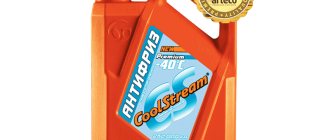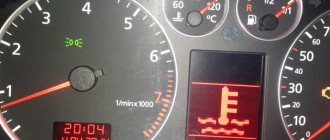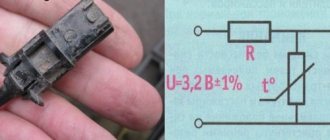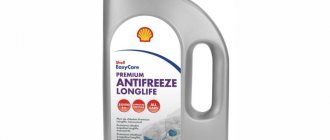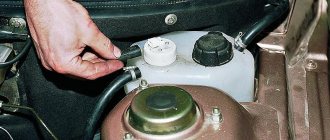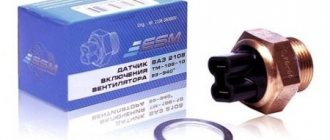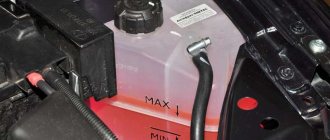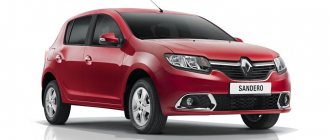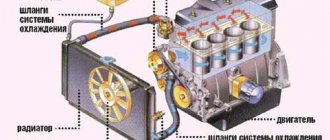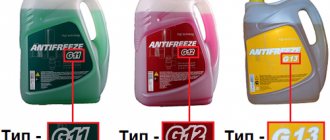The quality characteristics and level of coolant in the Renault Sandero crossover directly affect its operational efficiency, as well as the service life of the main vehicle systems. Therefore, in this article we will try to figure out what antifreeze to fill.
Selection of substance
As a coolant in Renault Sandero 1.6 cars, you need to fill in a substance of type D - GLACEOL RX. The liquid has a yellow color and medium viscosity. Also, in some Renault models, depending on the location of assembly, Cool Stream 4030 Premium coolant can be used as a replacement. In fact, hue in no way determines the characteristics or properties of a substance.
The total volume of the entire cooling system in Renault Sandero 1.6 cars, no matter what year of production they are, is 5.45 liters. There are marks on the expansion tank that can be used to determine how much substance is in the system. It is possible to purchase a concentrate for replacement and then dilute it with water. Catalog numbers of original substances for Renault Sandero cars with a 1.6 liter engine are 7711170545 and 7711170546.
This is interesting: Removing the Renault Duster fog light
2163-13-06a-04
We pour liquid into the engine cooling system through the expansion tank until liquid begins to flow out through the air bleeder fitting. We wrap the cap of the air release fitting and the cap of the expansion tank.
Let's start the engine. When the engine warms up, the outlet (lower) radiator hose should be cold for some time, and then quickly heat up, which will indicate the beginning of fluid circulation in a large circle. After waiting for the cooling system fan to turn on, stop the engine. After the engine has cooled, check the coolant level. If necessary, we bring it to normal.
The quality and required quantity of coolant in a Renault Sandero directly affects not only its performance, but also how long individual components and assemblies will last.
Liquid draining process
To remove the pipe, you need to pass a tight clamp. Please note that if there are clamps on the working hoses, you should replace them with new ones, because these elements are designed for one-time use only. Afterwards, the hose is carefully disconnected from the fitting and placed in a container. Next, the used antifreeze will flow simultaneously from two points: the radiator, the pipe. In order for the coolant to flow more actively, the cap of the expansion tank is removed, as well as the plug valve of the vertical fitting, located on a massive pipe, which goes to the body structure of the thermostat.
Preparing to replace antifreeze: important tips and tricks
For drivers of a car of this brand, it is better to replace the coolant in advance, namely when it becomes characteristically dirty-brown. In this case, the liquid will become unpleasant and smell sharp, and such changes will occur after 60 thousand kilometers.
To prepare for a simple operation to replace antifreeze, you will need several necessary items, including tools and consumables.
It is important to prepare several types of wrenches, among which there should be open-end and cap options. You should have pliers and a screwdriver on hand. To drain the waste liquid, you need to prepare a wide container with low sides, which would correspond to a volume of 6 liters. Many drivers use the neck of a plastic bottle as a funnel. It is necessary to stock up on rags and cloth or rubber gloves.
Undoubtedly, for convenience, you can use an inspection hole, since in the absence of one you will have to climb under the car and perform all the necessary manipulations while lying on the floor or ground. Before starting work, the engine must be completely cooled, and the valve located at the neck of the expansion tank must be unscrewed to reduce excess pressure in the cooling system. After the cover is removed, you will hear a characteristic sound, after which the cover should return to its place.
Unfortunately, Renault does not have any precautionary plugs or other devices for the release of used antifreeze, so it is drained after removing the system pipes. To begin, remove the lower hose from the radiator, unscrew and remove the tray protecting the crater, then place a container prepared in advance under the radiator. It is more convenient to carry out this work in an inspection hole, then you can throw a board over the hole and install a container on it to collect the waste product.
Step-by-step instructions for changing antifreeze in a car
Immediately before draining and replacing antifreeze in the Renault Sandero Stepway, it is necessary to prepare the car for the upcoming procedure. It is recommended to place the vehicle on a flat horizontal surface, without slopes or vertical elevations.
Important! According to the safety instructions, before changing the antifreeze in Renault Sandero Stepway, it is recommended to turn off the engine, let it cool and only then start working. The coolant heated when the engine is running remains in the expansion tank under high pressure. If the engine is not allowed to cool, a dense stream of antifreeze can burn the car owner's hands and face.
Next, you should take care of the appropriate tools. To change antifreeze in Renault Sandero Stepway you will need:
- Pliers;
- Key for 14 and 16;
- Screwdriver;
- Container for draining used antifreeze, with a capacity of at least 10 liters;
- Absorbent rag fabric;
- If necessary, additional replacement parts (pipes, valves, etc.).
The preparation procedure for changing antifreeze in a car’s cooling system usually takes no more than 1 hour. The process of replacing the coolant itself is divided into 3 stages sequentially:
- Stage 1 - draining outdated coolant from the Renault Sandero Stepway cooling system: The drain container is installed under the expansion tank;
- After the engine has cooled, carefully unscrew the drain tank cap. This is not recommended to be done abruptly due to the residual high pressure in the unit housing;
- Allow the used coolant to drain into the prepared container. In this way, you can test for clogging in the drain - if the substance does not pour out freely, this means that the drain is severely clogged;
- After draining used antifreeze, it is recommended to examine the contents of the drain container. If the technical fluid used is cloudy and has a pronounced sediment, this may indicate a corrosion process in the cooling system of the Renault Sandero Stepway;
- Screw in the drain plugs and return the expansion tank to its original position;
- Move the drain container under the vehicle cylinder block;
- Drain used antifreeze from the cylinder block;
- The flushing solution or distilled water is poured into the expansion tank until the “Full” symbol appears;
- Stage 3 - pouring fresh antifreeze. After the flushing has been completed, fresh coolant is poured into the expansion tank. It is important to note that if antifreeze concentrate is used as a coolant, it should be diluted with distilled water. The ratio of liquids depends on the desired boiling point of the substance and is indicated in the instructions for use of the concentrate. Then all the plugs are carefully screwed in, and final checks are made for the tightness of the cooling system, absence of leaks and defective parts.
Test drive New Renault Sandero 1.2: is replacement justified?
Cars in basic versions often raise doubts among buyers. The price seems to be good, but the equipment is without frills, there are few additional pleasant benefits, and most importantly, the engine is somehow weak. I wouldn't regret saving later. One of the best-selling models in Russia, the Sandero, aroused particular suspicion: in the new generation, the base 1.4 engine was replaced with a 1.2 engine. We check whether the manufacturer has saved...
I would like to say right away: the guys from Renault are great. While some are busy turning a car into a cross between a mobile iPhone and a dry closet, others, turning their noses up at their own complexes, are constantly shouting the word “premium” and “luxury”, the modest French are quietly doing their job - inexpensive, but very high-quality cars for the bulk of the poor population.
Yes, their price tags have risen recently too. But for now, Renault remains the brand where most of the models have some reasonable numbers in the price lists. Where, for example, will you now find a modern European car with thoroughbred settings and a normal standard size, the price of which will start with the number three - only in Renault.
A striking example is the new Logan line. The car, which has radically transformed in all respects and rubbed the noses of those who contemptuously spat at its peasant appearance and ascetic interior, has finally been replenished with the updated Sandero hatchback. Starting price – 391,000 rubles. But this is a completely empty car. In order for the car to meet at least some minimal requirements by modern standards in terms of equipment, you will have to pay at least 440,000 rubles.
Forget about the ax-chopped appearance of its predecessor. The new Renault Sandero has become rounder and dressed up. Design elements appeared in the exterior, and swiftness appeared in the gaze. The result of this transformation is the lack of perception of the “budget” of the car. The main advantages of the body – height and volume – have also been preserved. When entering the car, the car does not require acrobatic sketches, which will be especially appreciated by older people. And the cubic shape still contributes to the efficient use of space.
The new Renault Sandero is 60 mm longer, lower by 11 mm and narrowed by 20 mm in width. Ground clearance remains the same – a decent 155 mm.
The interior itself, which completely replicates the decoration of the new Renault Logan, has changed much more significantly than the exterior. Only the inexpensive and hard finishing plastic and the overall gloomy color palette remind of its former simplicity.
But in other respects it is a decisive step forward. The front panel curves modernly in smooth lines. The new steering wheel, molded to fit the correct grip, fits comfortably in your hands. Finally, the buttons for the power windows, mirror adjustments and sound signal are in place. The microclimate unit, which moved a little higher, became convenient to use. And Meganov’s instrument panel with chrome-plated scale edging is not only easy to read, but adds gloss to the interior.
However, not all of the shortcomings have been corrected. The steering wheel is still not adjustable for reach. The rustic seat is still suboptimal in shape and range of adjustments.
A separate topic is equipment. In the new generation, Sandero received, in general, all the achievements of higher-class cars as options. True, their availability varies depending on the selected configuration. Already in the second Confort version, the car is standardly equipped not only with ABS, front airbags and minimal power accessories, but even with cruise control.
The center console is topped with an optional multimedia complex with a touch screen, navigation system and the ability to pair with a phone. The graphics on it, of course, are simple, but the very fact of availability and low cost make its purchase justified.
Other section materials
| Technical description |
| dimensions |
| Vehicle Specifications |
| Vehicle registration details |
| Location of controls |
| Car keys |
| Doors, central locking |
| Ignition switch (lock) |
| Automatic transmission selector lever |
| Instrument cluster |
| Adjusting the front seats and steering column |
| Switches |
| Heating control unit |
| Front passenger airbag switch |
| Steering column switches |
| Headlight beam direction control |
| Rear view mirrors |
| Safety precautions during maintenance and repair |
| Location of the main components and assemblies of the car |
| Vehicle check |
| Maintenance schedule |
| Checking the condition of wheels and tires |
| Checking the fluid level in the windshield washer reservoir |
| Replacing windshield wiper blades |
| Checking the engine oil level 1.4–1.6 (8V) |
| Replacing engine oil and oil filter 1.4–1.6 (8V) |
| Replacing engine spark plugs 1.4–1.6 (8V) |
| Replacing the replacement element of the engine air filter 1.4–1.6 (8V) Renault Logan, Sandero |
| Replacing the drive belt for engine auxiliary units 1.4–1.6 (8V) Renault Logan, Sandero |
| Checking the condition of the engine gas distribution mechanism 1.4–1.6(8V) |
| Topping up engine coolant 1.4–1.6 (8V) |
| Replacing engine coolant 1.4–1.6 (8V) |
| Checking the oil level in the 1.6 (16V) engine |
| Changing the oil and oil filter of the 1.6 (16V) engine |
| Replacing spark plugs for a 1.6 (16V) engine |
| Replacing a replacement air filter element for a 1.6 (16V) Renault Sandero engine |
| Replacing the drive belt for engine auxiliary units 1.6 (16V) Renault Logan, Sandero |
| Replacing the timing belt of the 1.6 (16V) engine Renault Logan, Sandero |
| Checking the level and adding engine coolant 1.6 (16V) Renault Logan, Sandero |
| Replacing engine coolant 1.6 (16V) |
| Checking the level and adding oil to a Renault Sandero manual transmission |
| Checking the fluid level in the Renault Sandero brake system hydraulic reservoir |
| Replacing fluid in the hydraulic brake system |
| Bleeding the hydraulic brake system |
| Checking the fluid level in the power steering reservoir Renault Logan, Sandero |
| Checking the clutch release drive |
| Checking the condition of the brake system |
| Checking the condition of the chassis and transmission |
| Checking the steering condition |
| Checking the condition of the exhaust system |
This is interesting: Removing switches on the instrument panel console Renault Logan 2004-2009 Petrol
Features of the Renault Sandero maintenance schedule
Since Renault Sandero is designed on the basis of Logan, only as a compact five-door hatchback, the compatibility of both cars for spare parts is about 70%.
This means that the maintenance of a Sandero is not much different from the maintenance schedule for a sedan, because their transmissions and power units are completely identical.
Features of the Renault Sandero maintenance regulations
Sandero, despite belonging to the compact class, is a complex technical device consisting of tens of thousands of parts. Each component, each unit, despite its nominal autonomy, is highly dependent on the state of other systems, and if one of them is allowed to malfunction, this will affect the performance of the car as a whole.
Therefore, it is so important to monitor the condition of the vehicle, without ignoring routine maintenance, during which the car is thoroughly checked by experienced and qualified specialists.
The maintenance frequency for Renault Sandero (including the Stepway modification) is 15,000 kilometers.
Alternative hatchback maintenance dates are one year from the date of the previous maintenance.
What is included in the first maintenance (regarding free checks) is repeated in full in all subsequent ones. Zero maintenance is recommended to be carried out after 3 months from the start of operation or after driving 3000 km. mileage
List of checks (common for all maintenance):
- tightness of CO lines, exhaust system;
- clutch drive;
- monitoring the condition of drive joint covers;
- tire condition;
- integrity of suspension parts, ball joints, shock absorbers;
- power steering fluid level;
- control of the tightness of the power steering line;
- condition of steering elements;
- TJ level;
- condition of the brake system line;
- wear of brake discs/pads;
- battery;
- lighting devices (indoor and outdoor);
- switches, control buttons, instrument scales;
- rear/windshield condition;
- performance of front/rear wipers;
- condition of the anti-corrosion coating;
- lubrication of the hood lock.
Regulation TO-1 (15,000 km.)
When carrying out the first maintenance of Renault Sandero, the list of works includes checks from the general list, as well as the following replacements:
- engine oil with an oil filter (for the K7M engine we recommend MM Evolution 900 NF, catalog No. 0165469466R, for K4M - modification SXR, catalog No. 0194877);
- air filter (for K7M the filter with article number 0165469466R is suitable, for the K4M engine - 08200431051);
- drain plug gaskets.
Regulation TO-2 (30,000 km.)
When carrying out the second maintenance of Renault Sandero, it is necessary to perform all the work included in the basic list.
In addition, the following substitutions are made:
- engine oil with an oil filter (for the K7M engine we recommend MM Evolution 900 NF, catalog No. 0165469466R, for K4M - modification SXR, catalog No. 0194877);
- air filter (for K7M the filter with article number 0165469466R is suitable, for the K4M engine - 08200431051);
- drain plug gaskets;
- replacing spark plugs (for the K7M unit, products with catalog No. 07700500168 are suitable, for K4M - spark plugs 07700500155).
Drain the old fluid
The pipe in the Renault Logan is removed when the lock nut is first removed from the tightening clamp. Recommendation: if the hoses are secured with original Renault clamps, then they are replaced with new ones, since the old ones are disposable. Afterwards, the hose is twisted from the fitting and lowered into the container. The waste will drain in parallel from the pipe and the radiator. Then remove the cap of the expansion barrel and the plug from the vertical fitting located on the wide pipe fitting to the body of the thermostat. This is to increase the intensity of antifreeze drainage. And the coolant is replaced correctly and faster.
Due to the design features of the Renault Logan cooling system, these actions will not allow all the coolant to drain. A certain amount of it will remain in the radiator of the interior heater. To completely drain the waste, the pipes are unlocked and the clamps are removed from the two hoses that go to the thermostat, and the tubes themselves are lowered into the drain container. Then the cooling system is purged using compressed air supplied through the neck of the expansion tank and the holes in the thermostat housing. The operation is performed carefully without excessive pressure. Otherwise, the honeycomb of the interior heater radiator may be deformed.
After a certain time, during which the cooling system is completely empty, you can reinstall all components. All hoses are returned to their original places and secured with new clamps. Afterwards, new coolant is poured in, but which brand is decided by each individual. For some time, the Renault automaker filled the system with GLACELFAUTOSUPRA antifreeze from the TOTAL brand, painted in a bright yellow and pure yellow color spectrum. Since 2009, when antifreeze is replaced, GLACEOLRXTypeD, produced under the ELF brand, is poured into the system. It has a yellow tint, and before filling, the concentrate is diluted in a 1:1 ratio with distilled water for any volume. These two brands of antifreeze are characterized by excellent quality and are used for use on the French sedan Renault Logan with a 1.4 and 1.6 liter engine. They are purchased from the official Renault distributor. When replacing antifreeze, many are interested in the volume, it is within 5.5 liters, and the color of the liquid is determined through an Internet search. The outer packaging can be viewed in the corresponding video.
- Crawl under your car, then you should unscrew the so-called engine protection and remove the inner shield. This shield protects the left side of the engine from dirt getting into it. After this, place a canister under the drain to collect the mixture.
- Completely unscrew the drain plug of the engine cooling mechanism. Next, you need to unscrew the top part of the filler tank.
- You can also partially unscrew the plug (if the pressure level drops, unscrew it entirely).
- After draining the mixture from the radiator, screw everything back in as before. Loosen the compression force of the valve on the internal pipe, then drain the remaining mixture from the engine.
- Using a pump or syringe, it is worth pumping out the old antifreeze from the expansion tank and pouring in fresh one.
- Fill with fresh mixture until the mixture flows out. Next, simply close the lid.
Towards the end of replacing the antifreeze, you should definitely turn on the engine of your Logan and let it warm up before starting work (which, in general, will make it possible to make sure that the cooling system is working correctly).
After replacement, check the overall antifreeze level. If there is not enough antifreeze in the tank, bring it to the “F” mark.
- If on a heated engine there is no warm flow from the internal heater, this may indicate the appearance of a water/air plug in the cooling system. If the air is a little warm when the engine is running, then the fan is faulty, but if it is cool, there is a plug in the coolant mixture.
- Loosen the compression force of the valve on the internal radiator pipe, then unscrew it and drain the remaining mixture from the engine.
As can be seen from the text above, replacing antifreeze in a Renault Logan 1.6 8-valve version is essentially a fairly simple procedure. Doing this work on your Logan yourself gives you new knowledge and allows you to save money on repairing your car. This is also an overall great opportunity to get to know your car and see it in a new light.
The above instructions will allow the user to carry out re-solidification of antifreeze on their own without the help of people. Now you know how to do it. As a result, you also get the opportunity to save your money and, in the future, carry out this work more confidently.
Stages of replacing coolant in Renault Sandero
The procedure for replacing antifreeze is quite logical and understandable, although it has a number of nuances that are worth paying attention to. Unfortunately, the manufacturer did not provide drain taps for this task.
Detailed instructions for replacing coolant, suitable for Renault Sandero and Stepway modifications with an engine capacity of 1.4 and 1.6 where 8 or 16 valves are used. Structurally, the cooling system and power plants are similar and do not have any significant differences.
Coolant drain
To carry out an operation to replace antifreeze, it is better to drive the car into a pit or overpass, as we described in the example of Logan, but this is not always possible. Therefore, we will consider the option of replacing it ourselves when there is no hole.
It may not be strange, but doing this on the Renault Sandero Stepway is quite convenient; the car is very easy to maintain.
Everything is easy to reach from the engine compartment. The only thing is that it will not be possible to remove the engine protection, because of this the liquid will splash heavily, hitting and flowing down it.
So, let's figure out how to properly drain antifreeze:
- First of all, we remove the corrugation with the pipe so that subsequent operations can be performed more conveniently. One end just needs to be removed from the air filter housing. And the other end is attached behind the headlight; you need to feel the bulges on the pipe that hold it in place, press on them and remove them (Fig. 1);
Fig.1 Corrugation with pipe - unscrew the cap of the expansion tank to release excess pressure (Fig. 2);
Fig.2 Expansion tank cap - in the niche that opened after removing the air corrugation, at the bottom of the radiator, we find a thick hose. You need to remove the clamp from it and pull the hose up to remove it. The antifreeze will begin to drain; first, under this place we place a container for draining (Fig. 3);
Fig.3 Thick hose - To drain the old antifreeze more completely, simply remove the hose going to the thermostat (Fig. 4);
Fig.4 Hose on thermostat - On the hose going into the cabin we find the air vent and remove the cap from it. If you have a compressor, you can try to blow through the system through this hole; (Fig.5).
Fig.5 Air vent cap
Flushing the cooling system
When replacing antifreeze, it is recommended to flush the cooling system; if the replacement is carried out according to regulated periods, then there is no need to use special chemicals. It is enough to run it 3-4 times with distilled water.
To perform this operation, you can simply throw on the hoses without clamping them and warm up the car to the opening temperature of the thermostat. By the fourth time the water will be almost clean, you can start adding new antifreeze.
Filling without air pockets
After flushing the system and drying it as much as possible from distilled water, we proceed to the filling stage:
- put all the hoses in place, clamp them with clamps;
- through the expansion tank, we begin to fill the system with antifreeze;
- As it fills, air will come out through the vent hole, after which clear water will flow, some of which remains in the pipes after washing. As soon as the antifreeze flows, you can close the hole with a cap;
- add liquid to the level and close the expander.
The main filling operation is completed, all that remains is to expel the air from the system. To do this, you need to start the car and periodically increase the speed to warm it up for 5-10 minutes. Next, unscrew the expander plug and normalize the pressure.
We open the hole for the air to escape, slightly open the expansion tank, as soon as the air comes out, close everything. It is recommended to repeat all steps several times.
You need to understand that when the car is warm, the coolant is very hot; you need to act carefully so as not to get burned.
What to do if air gets into the cooling system?
During the process of replacing antifreeze with Renault Sandero Stepway, air enters the vehicle's cooling system. Getting rid of excess air is not difficult, just follow the action plan below:
- After filling in new antifreeze, start the car engine;
- Leave the car idling for 10-15 minutes;
- Stop the engine and examine the coolant readings. If the readings have decreased, add the missing amount of antifreeze.
This procedure is called running the engine. As a result of the run, the air freely leaves the Renault Sandero Stepway cooling system, providing the vacuum necessary for normal engine operation. It is enough to carry out this procedure only 1 time.
Timing for replacing coolant in Renault Sandero Stepway
The time frame for replacing antifreeze in Renault Sandero Stepway varies from 1 to 5 years of mileage. The exact period depends on the individual characteristics of each individual vehicle and is necessarily indicated in the operating instructions for the vehicle of the brand in question.
To fill the Renault Sandero Stepway cooling system you will need 5-5.5 liters of antifreeze, but it is recommended to stock up on 8-10 liters of coolant. This measure is due to the fact that when the car engine is running after filling, the antifreeze level may decrease and it will need to be topped up.
Sequence of work
A prerequisite for replacing antifreeze on a Renault Sandero is a cold engine. You also need to take care of personal protection. To do this, you can wear a respirator to prevent vapors from entering the respiratory system, gloves and glasses. The car must be on a horizontally level surface.
Before starting work, you need to check all connections for possible leaks, including the connections between the hoses and the thermostat housing. If the tightening is not tight enough, it is necessary to replace the metal clamps.
First you need to unscrew the cap of the expansion tank of the Renault car cooling system. Also, if there is engine crankcase protection, it must be removed. Then, using pliers, you need to loosen the clamp that secures the lower radiator hose of the car. The clamp is lowered along the length of the hose. At the next stage, you need to remove the hose from the radiator pipe and drain all the contents into a container that was prepared in advance. You must wait until the system is completely empty. After this, you need to tighten the valve plug, which is designed to release air. It is recommended to pour a little water through the expansion tank to flush the pipeline. Then, using a compressor, you need to blow out the remaining water from the system.
Replacement frequency, what antifreeze to fill
The manufacturer recommends replacing the coolant after 90,000 kilometers or 3 years of operation. In most cases, this period is optimal, provided that you use the recommended antifreeze.
If you fill in the original liquid, then it will of course be Renault Glaceol RX type D, code 7711428132 liter bottle. But if you can't find it, don't be upset.
Renault Sandero can also be filled with other antifreezes from the factory, for example, Coolstream NRC, SINTEC S 12+ PREMIUM. It all depends on the place of production of the machine and the concluded supply contracts. Since it is expensive to transport “water” from abroad, it is cheaper to use what is produced by local enterprises.
You shouldn’t save money and fill Sandero Stepway with antifreeze, especially since the savings won’t be significant.
If we talk about analogues or substitutes, then any brand that has Type D approval recommended by the French automaker will do.
Volume table
Choosing coolant
The composition of antifreeze is general, regardless of type: distilled water, ethylene glycol and other impurities. The only differences are in shade and specification. It is the purpose that determines the choice of liquid of one brand or another. The instructions that come with the machine indicate which antifreeze to fill, that is, it should be used to cool the machine’s systems.
At the factory, the Renault Sandero Stepway crossover system is filled with Type D. The color palette of this coolant varies. The factory tint is usually green. However, blue, yellowish or with a red spectrum will also work. The main thing is that it does not contain silicates.
Typically, factories that produce auto chemicals receive approval from automobile companies in the form of permitting certificates. Therefore, antifreeze for Renault Sandero Stepway will have the appropriate marking, in the form of the name Renault, which does not allow you to make a mistake when choosing a refrigerant. So, we found out what antifreeze to fill.
How to select and replace coolant for Renault Sandero?
Experienced motorists know that the quality of the coolant directly affects the performance of the engine. Therefore, attention should be paid to replacing this consumable item from time to time. Now we will tell you what kind of antifreeze you need to fill in for Renault Sandero, how often it should be done and how the process of changing the fluid takes place.
Why do you need to replace antifreeze on a Renault Logan car and when to do it?
A liquid that has used up its life changes its properties and can cause many negative aspects. It’s easy to determine the degree of its suitability - just open the filler cap of the tank and examine the contents. If the coolant has changed color or acquired a brown tint with sediment, this indicates the need for urgent rotation of the refrigerant.
Based on the recommendations of the manufacturer, replacing the coolant with Renault Logan is carried out in the following cases:
- After every 90,000 km .
- Every 6 years of operation.
The volume of the cooling system of a car with air conditioning is 5.45 liters , and without it – 4.5 liters. New chemical solutions make it possible to increase the interval to 100 - 110 thousand km, but in any case, visual inspection at least 2-3 times a year is necessary.
Why is it important to change the coolant?
Automotive fluids contain not only mixtures of ethylene glycol and monohydric alcohols, but also anti-corrosion additives. Depending on the type of corrosion inhibitors, coolants are divided into:
- G-11 – based on silicate or nitrite additives.
- G-12, G-12+ – based on carboxylic acids.
- G-12++ – includes organics and mineral inhibitors.
Mixing all types is not recommended, although the first two are, in principle, allowed. However, it should be taken into account that the service life of the coolant in this case is reduced. Why all these subtleties? The fact is that over time, the properties of chemical additives are lost, and ethylene glycol paired with water begins its corrosive activity. This threatens:
- Possibility of thermostat jamming due to the presence of corrosion products.
- Destruction of the water pump impeller.
- Depressurization of pump bearings.
- Clogged radiator and internal combustion engine channels.
All of the above factors will certainly lead to overheating of the engine, resulting in excessive fuel consumption and a decrease in power. Regular overheating reduces the operational life of the power unit several times. Such consequences can be avoided by timely replacement of the antifreeze that has expired in full with Renault Logan. In addition, it is important to monitor its condition by periodically looking into the expansion tank.
What do you need to prepare to perform the operation?
To carry out the work, it is necessary to prepare the following tools and materials:
- Set of open-end and spanner wrenches.
- Set of screwdrivers and pliers.
- Plastic funnel.
- A capacity of at least 6-7 liters.
- Gloves and overalls.
- Coolant 6 liters.
- Worm clamps.
What antifreeze is needed for Renault Logan?
Current Renault engines use type D fluid, which meets the G-12 standard:
- Cool Stream 4030 Premium.
- Glacelot RX (Type D).
These brands are available for sale both in diluted and concentrated form, sold in liter canisters. Before pouring into the internal combustion engine, such a mixture is diluted with distilled water, usually in a 1:1 ratio, and the pour point is -36°C. Thus, Logan will need three liter containers.
- Liqui Moly KFS 2001.
- CoolStream Premium.
- Aral 4003116908396 Silikatfre.
- GlycoShell Longlife.
- SWAG 60 ANTIFREEZE (Green).
- Kuhlerschutz SF.
Important! Even if it is not possible to purchase the right brand of auto fluid, you should add only carboxylate-type mixtures!
What antifreeze to use for Renault Logan
First, you should clearly understand the following rule: you should only pour coolant into a clean system. This will allow the new antifreeze not to lose all its qualities when mixed with a used product.
Its chemical composition contains the substance ethylene glycol, distilled water and additives consisting of components such as an aqueous solution, glycerin and alcohol. Ethylene glycol and water are the basis of the liquid, which makes up 96 percent of the total volume, the rest is additives. They help combat corrosion in a wide range of radiator cooling systems, namely those made from cast iron, copper and aluminum.
Before using the concentrate, it must be diluted with distilled water in a ratio of 50X50. And as a container for dilution, you can use plastic bottles of one and a half or two liters. The resistance to winter temperatures of the finished antifreeze inspires confidence; it does not freeze at -35.40 degrees below zero. By changing the dilution ratio, for example to 30x70, you can operate the car in different climatic zones.
Antifreeze from the manufacturer Total is safe for plastic and rubber products, as well as for containers painted with paint or varnish. In order to completely fill Renault Logan with new coolant, it is necessary to prepare 608 liters of working product the day before, its quantity depends on the appetite of the engine. You can get this amount of antifreeze by purchasing at least 3-4 liters of concentrate. The remainder will be used for refilling during use of the car, so you should always have it in the trunk.
Antifreeze type GLACEOL RX Type D costs from 330 to 350 rubles per liter, but it is advisable to purchase from trusted sellers or official dealers so as not to “run into” a fake. Distilled water is also sold in specialized auto stores and can be purchased without any problems.
Replacement features
Preparation
What you need to prepare in order to cope with the process of changing the coolant as quickly and conveniently as possible:
- the refrigerant itself;
- clean rags;
- container into which you will drain waste consumables;
- pliers.
Step-by-step instruction
- The work of changing the coolant must be carried out on a cold engine. Therefore, let the engine cool down, after which you need to relieve the pressure in the cooling system. To do this, open the hood and find your expansion tank. Remove the lid from it: this will release the pressure.
- Now you need to remove the engine protection. In Renault Sandero models, the developers did not provide holes for draining consumables in the engine and radiator. Therefore, place a previously prepared container under the radiator.
- To begin the process of draining the antifreeze, you will need to disconnect the outlet pipe from the lower radiator hose, having previously removed the clamp securing it.
- Disconnect the clamp: to do this, use a flat-head or Phillips screwdriver and unscrew the fastening screw.
- Now you can remove the outlet pipe from the hose and drain the used consumables.
- To increase the intensity of draining spent consumables, you can remove the fitting cap, which is installed on the coolant supply pipe to the heating device.
- When the antifreeze has completely drained from the system, put the radiator hose outlet pipe back in place and secure it with a clamp. There is a possibility that the old clamp will not be suitable for reuse, so you will have to buy a new one. Instead of the standard clamp that was installed, you can use a worm clamp.
- Now you need to pour coolant into the engine cooling system through the expansion tank. Pour in antifreeze until it begins to flow out of the air bleeder fitting. When this happens, replace the fitting cap. Also tighten the expansion tank cap.
- Start the engine. When the engine warms up, the lower radiator hose should be cold for some time, after which it will quickly begin to heat up. This indicates that coolant circulation has begun in a large circle in the cooling system. When the system fan turns on and starts working, the motor must be turned off. When the engine has cooled down a bit, check the antifreeze level. If necessary, add consumables to the system.
- It would also be a good idea to check the condition of the pipes and joints for leaks. If the liquid has just been filled, this is even easier to do: you will see the places where there is a leak immediately, since they will be highlighted with the color of the antifreeze being poured.
2271-3-7-07-03
Before replacement, you need to stock up on a worm-drive clamp for cooling system hoses with a working range of 35-50 mm. If the engine is hot, you need to let it cool and then relieve excess pressure in the cooling system by opening the expansion tank cap. We remove the protection of the power unit. The radiator and engine cylinder block do not have plugs for draining fluid. We place a wide container with a volume of at least 6 liters under the radiator. To reduce the intensity of liquid drainage at the initial moment, the cap of the expansion tank should be tightly screwed on.
Leaks and problems
When replacing coolant, you should pay attention to defects in the hoses; if there is the slightest doubt about their integrity, then you should take care of replacement.
It is also advisable to inspect the expansion tank; it is not uncommon for the internal partition to simply dissolve over time and clog the cooling system with flakes of plastic particles. To search for and purchase a barrel, you can use the original number 7701470460 or take the analogue MEYLE 16142230000.
The cover is also periodically changed, original 8200048024 or an analogue ASAM 30937, since the valves installed on it sometimes stick. Increased pressure is created and, as a result, leakage occurs, even in a seemingly serviceable system.
There are cases of thermostat failure 8200772985, improper operation or gasket leakage.
The clamps used in this Renault model also cause criticism from motorists.
They come in two types: low-profile with a latch (Fig. A) and spring-spring (Fig. B). Low-profile with a latch, it is recommended to replace it with a regular worm-type one, since it is not always possible to clamp the original one without a special key. A diameter of 35-40 mm is suitable for replacement.
You can try to put the spring-spring one in place using pliers, but this requires a little skill.
